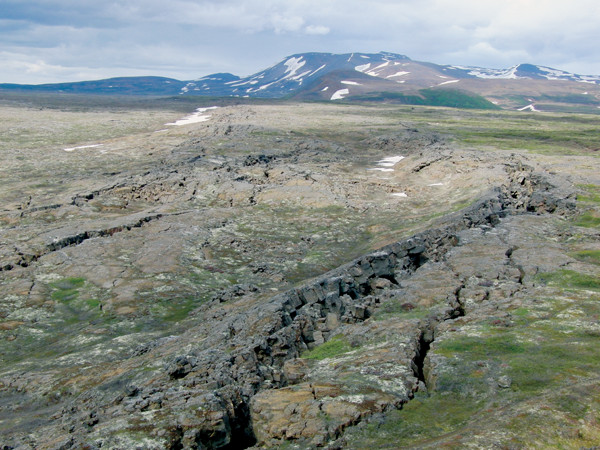
by Timothy Oleson Tuesday, December 9, 2014

The Husavik-Flatey Fault cuts across part of northern Iceland near the town of Husavik. An earthquake on this fault in 2012 was one of two found recently to correlate with significant changes in groundwater chemistry measured months before the quakes occurred. Credit: Alasdair Skelton.
Scientists tracking groundwater in Iceland have reported that significant shifts in the water’s chemistry occurred months prior to earthquakes in 2012 and 2013. It’s far too early to apply the findings to earthquake hazard assessment, researchers say, but the results suggest that precursory groundwater changes may also herald earthquakes elsewhere and point toward a potential means of future seismic monitoring.
Every week from 2008 to 2013, Alasdair Skelton, a geochemist at Stockholm University in Sweden, and his team sampled groundwater from a 100-meter-deep, free-flowing artesian borehole at Hafralækur in northern Iceland, measuring isotopic ratios and concentrations of dissolved ions in each sample. Several moderate-sized earthquakes — with epicenters roughly 80 kilometers from the borehole — occurred in the area during that time, including a magnitude-5.6 quake in October 2012 and a magnitude-5.5 quake in April 2013. Statistically significant changes in the groundwater’s composition occurred before both of those events, the team reported in Nature Geoscience.
“The hydrogen isotope signature changed quite a lot in the four to six months before both of the earthquakes,” Skelton says. “The same happened with the sodium concentration in the groundwater. That increased, and again it was significantly above background before both earthquakes.” Apparent jumps in the concentrations of silicon and calcium also coincided with the lead-ups to both events, although Skelton notes that these increases could not be distinguished statistically from the background levels.
“The elements that we see changing in the groundwater are the elements that are [common] in the rocks,” Skelton says, which in Iceland are primarily basalt. “So we’re seeing interactions between the groundwater and the rock recorded in the water’s chemistry,” he says. Changing isotopic ratios in the groundwater studied, on the other hand, “tell us more about mixing between different aquifers” that contain water of different ages and different initial isotopic compositions.
Both lines of evidence suggest the changes are happening due to dilation, or cracking, of the rock caused by increases in local strain associated with stress buildup on nearby faults, Skelton says. “There is volume expansion that leads to cracking of the bedrock, which changes its permeability,” meaning water from once-separate aquifers can mix, he says. “And then, of course, you get new [rock] surfaces exposed, and they are quite chemically reactive.”
The research isn’t the first to offer evidence of groundwater changes preceding earthquakes. In a pair of 1995 studies, scientists reported rising levels of radon, chloride and sulfate in groundwater near Kobe, Japan, prior to the magnitude-6.9 earthquake that struck the city in January of that year. But the new Iceland study is the first to observe consistent changes in a single groundwater source from multiple earthquakes.
“The key to … their results was that they stuck at it long enough to see multiple events, and also they were monitoring multiple constituents” in the water, says Steve Ingebritsen, a hydrogeologist at the U.S. Geological Survey in Menlo Park, Calif., who co-authored a commentary, also in Nature Geoscience, on the new study. “It takes a lot of effort to put together a time series that is adequate to support statistical analysis, and they did so.”
Changes in groundwater composition associated with earthquakes “are not entirely unexpected, because there can be ground deformation in the time leading up to an earthquake,” Ingebritsen says. Nonetheless, he says, such changes are often hard to explain, as in this case, because the expected strains on rocks far from the faults where stress is accumulating are “very small” — smaller than those caused by atmospheric pressure shifts or daily Earth tides, for example, and too small to even be “detectable in our geodetic networks.”
How such slight seismic strains specifically are causing dilation “remains pretty enigmatic to me, and I think probably to most people,” Ingebritsen says. “Some level of skepticism is going to persist until we have more examples at least as equally convincing as Kobe and this Icelandic example.”
There’s no telling how common such groundwater changes are before earthquakes, but if they happen in one or two places around the world, it’s possible they happen elsewhere, Skelton and his colleagues noted. “The specific changes we observed are dependent on the hydrology of that one location [at Hafralækur], but that changes should occur is not location-dependent,” Skelton says.
© 2008-2021. All rights reserved. Any copying, redistribution or retransmission of any of the contents of this service without the expressed written permission of the American Geosciences Institute is expressly prohibited. Click here for all copyright requests.